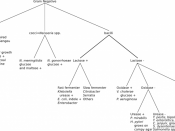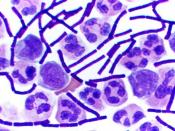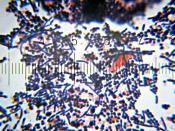Introduction
Bacteria are prokaryotic organisms, meaning that that are made of a single cell
and they have no membrane bound organelles. They are found almost everywhere on the planet. They usually have one of three shapes: bacilli (rod-shaped), cocci (sphere-shaped), or spirilla (spiral-shaped). (Postlethwait and Hopson, 2009)
Cocci occurring in chains are called streptococci. Clusters of cocci are called
staphylococci. Two connected cocci are known as diplococcus. Four connected cocci are referred to as a tetrad. Eight connected cocci are called a sarcina. Two connected bacilli are known as diplobacillus. Bacilli occurring in a chain are referred to as streptococcus. (Postlethwait and Hopson, 2009)
In bacteria, there are many structures. The first structure that is noticed on a bacterium is the capsule, which is an outer covering of the bacteria and helps the cell attach to other surfaces. It also protects the bacterium from outer environments. (Postlethwait and Hopson, 2009)
Another form of protection for the cell is the cell wall.
This structure also helps give the cell its shape. Although the next structure, the cell membrane, is another covering, it also controls the types of particles that enter and exit the cell. (Postlethwait and Hopson, 2009)
The cytoplasm is the main area of the innards of the bacteria. It contains many of the cell's structures. One structure is contains is called a plasmid, which carries genes that are used to transfer DNA (genetic material that determines an organism's traits) during reproduction. This small, circular DNA loop is the reason for genetic recombination in bacteria. The main area where DNA is contained, however, is in the chromosome, which carries the genetic information from one generation or type of bacteria to the next. Another structure that contains DNA is called an endospore. An endospore is a thick-coated resistant structure that develops...


